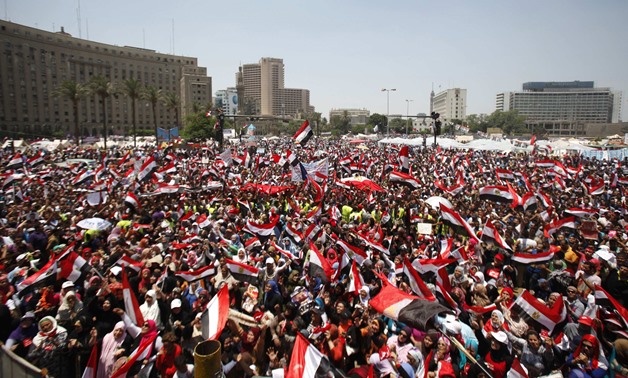
FILE- Egyptians protest against the regime of the Muslim Brotherhood in 2013- Reuters
CAIRO - 5 June 2021: Egypt’s population would increase about 75 million people by 2050, which represents considerable pressure on water resources, amid the climate change impacts, said Egyptian Minister of Water Resources and Irrigation in a meeting with a number of lawmakers and members of the Coordination’s Committee of Party’s Youth Leaders and Politicians [CPYP] on Saturday at the Ministry headquarters in Giza.
He added that Egypt is witnessing extreme and unprecedented weather phenomena such as intense rain that hits separate parts of the country, besides a rise in sea level and its dangerous negative impact on cities and coastal areas.
“Egypt is one of the countries that suffer the highest risk of water scarcity as Egypt's water resources are estimated at about 60 billion cubic meters of water annually, most of which comes from the Nile River, besides very limited amounts of rainwater and deep groundwater in deserts,” he said, adding that the 100-million Egyptians’ total water needs amount to about 114 billion cubic meters annually, and this gap is compensated through the reuse of agricultural wastewater and surface groundwater.
Abdel-Atti continued that Egypt gets 34 billion cubic meters of water annually in importing food products from abroad.
In response to this situation, the government has prepared a strategy for water resources until 2050 at a cost of up to LE 900 billion pounds, besides developing a national plan for water resources until 2037 that relies on four axes: rationalizing water use, improving water quality, providing additional water sources and creating the climate for optimal water management, he said.
As for the ongoing dispute between Egypt, Sudan and Ethiopia over the Grand Ethiopian Renaissance Dam (GERD), Abdel Antti said that Egypt is keen to resume the negotiations over the outstanding issues regarding the dam’s operation and filling its water.
He emphasized Egypt’s stance towards reaching a just and legally binding agreement that meets the aspirations of all countries for development, stressing that any action that would be taken without reaching a just and binding legal agreement and without coordination with the downstream countries is a rejected unilateral act.
“Egypt supports development in the Nile Basin countries and African countries.. Egypt has established several surface water [catchment] and storage dams and stations for underground water to provide pure drinking water in remote areas,” Abdel-Antti said.
In mid-July 2020, Ethiopian authorities unilaterally carried out the first phase of the filling process with 4.9 billion cubic meters; and it is expected that the second phase of the filling would reach 13 billion cubic meters.
The dispute among Egypt, Sudan, and Ethiopia dates back to May 2011 when Ethiopia started building the dam; Egypt voiced concern over its water share [55.5 billion cubic meters].
In 2015, the three countries signed the Declaration of Principles, per which the downstream countries should not be negatively affected by the construction of the dam, whose capacity is 74 billion cubic meters and is planned to generate 6,000 megawatts per annum through 16 turbines.


Comments
Leave a Comment